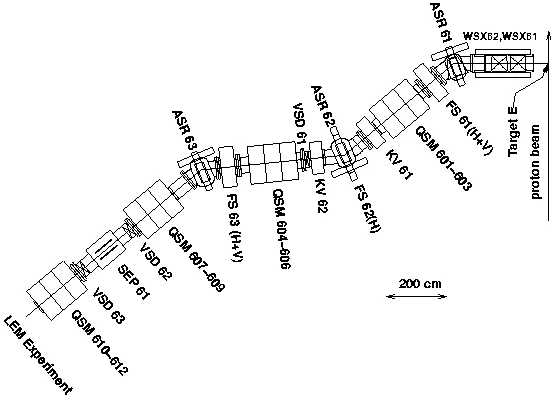The rebuilt µE4 beam is a large acceptance beam line for muons with low momentum (< 40 MeV/c). It was specially designed to serve the needs of the low-energy muon (LEM) beam facility at PSI, i.e. maximum µ+ intensity at 28 MeV/c and a beam spot fitting to the size of the muon moderator target of the LEM apparatus. In order to keep costs and time for reconstruction low the new beam line had to follow the existing µE4 channel until the end of the main shielding of the proton beam. The large acceptance is achieved by using two normal conducting solenoids (WSX61 and WSX62) as the first focusing elements feeding the 40o degree bending magnet (ASR61). This magnet has a pole face rotation of 33o degree at the entrance and exit in order to provide momentum dispersion in the center of the second bending magnet ASR62 where the momentum bite can be varied by a horizontal slit system (FS62). ASR62 and ASR63 have rectangular pole shoes and bend by 34o degree each. The two vertical and horizontal slit systems FS61 and FS63 can be used to reduce the intensity. Focusing is done with four triplets of large aperture (QSM601 - QSM612) quadrupole magnets. A new static separator (SEP61) with crossed electric and magnetic field (E x B) strongly reduces the electron/positron contamination. The maximum fields will be 22.2 kV/cm (400 kV, 18 cm gap between the electrode plates) and 50 mT.
Besides the reconstruction of the µE4 channel the experimental area has been rebuilt to provide sufficient space for the LEM apparatus and other experiments.
The beamline has been commissioned during 2005. The LEM experiment started successfully with an engineering run between october and december 2005 to test and put into operation the completely new setup with new data acquisition hard- and software and a new slow control system.
Beam transport calculations
We compared the beam properties of the new µE4 beam line with the existing piE3 beam line (achromatic mode) where the LEM experiments are presently performed. Two modes of operation are possible for the new beam line: when using the full acceptance the momentum resolution is limited to 5%. With a reduced acceptance the momentum resolution can be improved to 1.8%. The corresponding Transport beam envelopes are shown here.
An estimate of the vertical beam shift due to horizontal WSX misalignment is shown here. In order to correct a possible vertical beam shift the first QSM triplett can be operated asymmetrically. This introduces an effective magnetic dipole component that allows vertical steering of the beam.
The measured beam transport properties and a comparison with the calculations can be found in
T. Prokscha, E. Morenzoni, K. Deiters, F. Foroughi, D. George, R. Kobler, A. Suter, V. Vrankovic, The new µE4 beam at PSI: a hybrid-type large accpetance channel for the generation of a high intensity surface-muon beam, Nucl. Instr. Meth. A 595 , 317 (2008), doi:10.1016/j.nima.2008.07.081.
An estimate of the vertical beam shift due to horizontal WSX misalignment is shown here. In order to correct a possible vertical beam shift the first QSM triplett can be operated asymmetrically. This introduces an effective magnetic dipole component that allows vertical steering of the beam.
The measured beam transport properties and a comparison with the calculations can be found in
T. Prokscha, E. Morenzoni, K. Deiters, F. Foroughi, D. George, R. Kobler, A. Suter, V. Vrankovic, The new µE4 beam at PSI: a hybrid-type large accpetance channel for the generation of a high intensity surface-muon beam, Nucl. Instr. Meth. A 595 , 317 (2008), doi:10.1016/j.nima.2008.07.081.
Beamline elements: calibration, power supplies, settings
- Calibration of magnets and slits
- List of power supplies (with DAC values used before 2013)
- The control system of the beam line has been changed to EPICS in 2013.
- Beamline settings for 28 MeV/s, separator off (e+/µ+ = 4):
- WSX on (2013: epics control system, magnet currents given in Ampère instead of DAC values), max. intensity with best focussing on LEM moderator target (3 x 3 cm2, 0.5m downstream of QSM612), momentum width 9.5%(FWHM). µ+ intensities (for 40mm target E): 228 M/mAs (per mA of proton current) integral, and 98 M/mAs on moderator. At 300 kV separator voltage the rates reduce to 210 M/mAs and 86 M/mAs, respectively. For 60mm target E length, the rate on moderator is about 50% higher.
- WSX off (DAC values used before 2013), low intensity with good momentum resolution of 1.5% (FWHM). µ+ intensities (for 40mm target E): 0.46 M/mAs integral, and 0.42 M/mAs on moderator.
